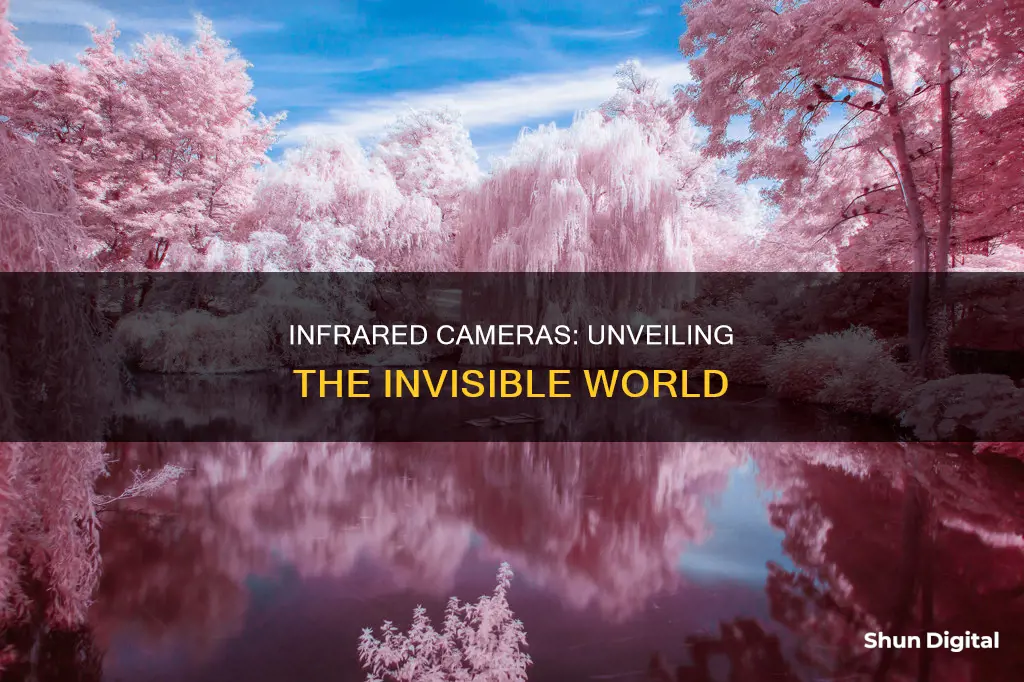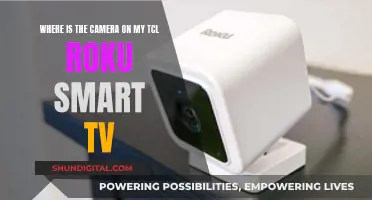
Infrared cameras, also known as thermographic cameras, capture images using thermal energy, or heat, rather than visible light. This allows them to detect and measure the heat emitted by objects, known as their heat signatures. By converting this heat data into an image, infrared cameras enable us to see heat and visualise temperature differences. This technology is known as thermal imaging and has a wide range of applications, from industrial inspections to building maintenance, emergency services, astronomy, and more.
| Characteristics | Values |
|---|---|
| What do infrared cameras see? | Infrared cameras can see thermal energy, or heat, emitted by objects. They detect and measure the infrared radiation or heat signatures of objects and convert this data into a visual image. |
| How does it work? | Infrared cameras capture the infrared radiation emitted by objects and process this data through built-in software. The software then translates the data into a thermal image or thermogram, representing temperature variations through a colour palette. |
| What is a thermogram? | A thermogram is a visual output produced by thermal imaging processes, representing varying levels of infrared radiation emitted by objects. |
| How is it different from a conventional photograph? | Unlike conventional photographs that capture visible light reflected off objects, thermograms represent infrared radiation emitted by objects. |
| What are the applications of infrared cameras? | Infrared cameras are used in industrial inspections, building maintenance, security and surveillance, firefighting, disaster response, medical and veterinary applications, geological and environmental studies, and astronomy. |
| What are the limitations of infrared cameras? | Infrared cameras cannot see through walls, glass, concrete, or metal objects. They are also ineffective underwater due to the blocking of infrared wavelengths by water. |
What You'll Learn

How do infrared cameras work?
Infrared cameras work by detecting and capturing wavelengths of light invisible to the human eye. All objects radiate energy, but some wavelengths within the electromagnetic spectrum are invisible. Infrared cameras can detect this radiation and express each heat value or wavelength through a set of corresponding colours. The resulting image is called a thermography.
Infrared cameras capture images of objects radiating light that is invisible to the naked eye. Detectors in an infrared camera capture a particular range of invisible energy emissions (700-1000 nm) and then express each heat value or wavelength through a set of corresponding colours. The final image shows the full temperature of every pixel, not just the average.
Infrared cameras can be used to detect the temperature of objects, with the data converted into a coloured representation of the scene. The camera's settings can be adjusted to show different temperature gradients. The higher the temperature of an object, the more radiation it emits.
Infrared cameras are made up of a lens, a thermal sensor, processing electronics, and a mechanical housing. The lens focuses infrared energy onto the sensor. The sensor can come in a variety of pixel configurations, which is the resolution of the camera.
Infrared cameras have a wide range of applications, including temperature screenings in workplaces, home inspections, medical imaging, astronomy, and climate studies. They are also used in surveillance, military operations, building inspections, firefighting, autonomous vehicles, and automatic braking.
Neighborhood Watch: Cameras Keep a Close Eye
You may want to see also

What is thermal imaging used for?
Thermal imaging is a versatile technology with a wide range of applications across various sectors. Here are some of the key uses of thermal imaging:
Industrial Applications
In industrial settings, thermal imaging is crucial for preventive maintenance. It helps detect abnormal heat patterns that could indicate overloads or impending equipment failures. By identifying these issues early, thermal imaging enhances operational efficiency, safety, and cost savings. Thermal imaging can also be used to inspect machinery and electrical circuits, preventing overheating and improving safety.
Building Maintenance and Construction
Thermal imaging is commonly used in building maintenance to detect heat loss due to poor insulation or air leaks. It helps identify areas where energy efficiency can be improved. Additionally, thermal imagers can detect water leaks within walls or beneath floors, helping to locate issues without the need for destructive inspections. In construction, thermal imaging is useful for quickly identifying structural defects and analysing a building's thermal performance.
Medical and Veterinary Fields
Thermal imaging cameras can detect changes in body temperature, making them valuable tools for early disease detection, such as in the case of breast cancer. In veterinary applications, thermal imaging can aid in the diagnosis of health issues in animals as well.
Security and Surveillance
Thermal imaging plays a vital role in security and surveillance operations. Thermal imagers can detect heat signatures, making it possible to identify intruders or trespassers, especially in low-light or adverse weather conditions. This technology is also used in search and rescue operations to locate missing persons or animals by detecting their body heat.
Firefighting
Firefighters utilise thermal imaging to navigate through smoke-filled environments and identify hot spots during rescue missions. Thermal cameras allow them to see through smoke and quickly locate fires, enabling them to intervene before they spread.
Transport Navigation
Transportation sectors, such as maritime navigation and automotive, benefit from thermal imaging. It helps seafarers detect other vessels, people, and obstructions during night-time voyages. In cars, infrared cameras are being incorporated to alert drivers of people or animals beyond the reach of headlights or streetlights.
Pest and Animal Management
Thermal imaging is used in pest and animal management to detect the presence of pests or animals in concealed areas, such as dark roof spaces. It also aids in wildlife surveys, providing a non-invasive method for studying animals in their natural habitats.
Science and Research
Scientists and researchers use thermal imaging to accurately visualise heat patterns, such as those on the dark side of the moon. This technology enhances their understanding of thermal energy and its applications.
Other Applications
Thermal imaging has numerous other applications, including heating, ventilation, and air conditioning installations, mould detection, and quality assurance in manufacturing processes such as glass production.
Hacking Cameras: Watch Dogs Style Guide for Beginners
You may want to see also

Do thermal cameras work through glass?
Thermal cameras, also known as infrared cameras, are a powerful tool with a wide range of applications. They can be used in building maintenance to detect heat loss, poor insulation, or water leaks, and are invaluable in industrial inspections for identifying potential problems like overheated components or insulation failures. They are also used in medical applications, search and rescue operations, and even ghost hunting!
But do thermal cameras work through glass? The short answer is no. Glass acts as a mirror for infrared radiation. When you point a thermal camera at a window, it detects the reflected temperatures of objects rather than transmitting infrared radiation through the glass. In other words, you will see a reflection of yourself in thermal instead of what's on the other side of the glass. This is because glass is a highly reflective material. The same principle applies to other reflective materials, such as polished metal.
However, it is worth noting that with high-end, professional-grade cameras, it might be possible to see through the glass to a certain extent. The image quality would be significantly degraded due to the glass filtering out infrared information.
Rear-View Vehicle Cameras: A Watchful Eye on the Road
You may want to see also

Do thermal cameras work underwater?
Infrared cameras, or thermal cameras, work by detecting the heat emitted by objects and converting it into an electronic image. This technology is particularly useful in identifying temperature anomalies, such as overheating machinery or electrical circuits, heat loss due to poor insulation, or water leaks.
Now, do thermal cameras work underwater? The answer is yes, but with some important nuances to consider. Firstly, water is a denser medium than air, and its stability is constantly changing due to waves, eddies, and currents. This dynamic nature of water can distort the reflection of infrared light, affecting the performance of thermal cameras underwater. Additionally, seawater contains salts, which further hinder the passage of light waves.
To address these challenges, underwater night vision devices are designed to be waterproof and withstand specific dive depths. These devices often incorporate modern electro-optical converters, which enable clear images even in low-visibility conditions. The use of thermal imaging cameras for underwater work offers advantages such as compactness and digital image enhancement.
It is worth noting that the functionality of thermal cameras underwater is also influenced by factors such as distance and sea currents. Despite these considerations, underwater night vision technology has proven valuable in various applications, including military activities, search operations, diving, and sea hunting.
Disable Camera and Microphone on Your TV: A Step-by-Step Guide
You may want to see also

Can thermal cameras see through walls?
Thermal cameras, also known as infrared cameras, are a valuable tool in a variety of industries. They can be used to detect problems that would otherwise be invisible to the naked eye, such as leaks, insulation issues, and overheating components. However, a common misconception is that these cameras can see through walls.
In reality, thermal cameras cannot see through walls or concrete structures. Walls are typically thick and insulated enough to block infrared radiation from the other side. When a thermal camera is pointed at a wall, it detects the heat coming from the wall itself rather than what's behind it. However, if there is a significant temperature difference caused by something inside the wall, a thermal imager may be able to sense it on the wall's surface. For example, if there is a hot or cold pipe within the wall, a thermal camera is likely to detect it.
Thermal cameras work by detecting and measuring the infrared energy emitted by objects, which is then converted into an electronic image. This allows the camera to show the apparent surface temperature of the objects it measures. The camera's optical system focuses the infrared energy onto a detector chip, which contains thousands of pixels that react to the infrared energy and produce an electronic signal. The camera's processor then translates this signal into a colour-coded thermal image.
While thermal cameras cannot see through solid objects like walls, they can detect subtle heat signatures that transmit from internal elements through barriers. This is because certain materials, such as concrete, have low emissivity, meaning they do not efficiently emit the infrared radiation that thermal cameras capture. However, heat from internal components like pipes, wires, and ducts can radiate through these materials to the surface, creating detectable heat patterns.
Skilled thermographers can interpret these heat patterns to identify thermal irregularities that indicate issues such as leaks, blockages, or breaks in insulation. By using building plans that indicate the locations of internal elements, inspection teams can ensure that thermal images provide accurate diagnostic information.
Hooking Up a DVR to a Camera and TV: A Guide
You may want to see also
Frequently asked questions
Infrared cameras are used for a wide range of applications, including:
- Building inspections to detect heat loss, poor insulation, or water leaks.
- Industrial inspections to identify overheated components, insulation failures, or other potential problems.
- Firefighting to help locate survivors and navigate through smoke-filled buildings.
- Search and rescue operations to spot heat signatures in large tracts of wilderness.
- Security and surveillance to detect intruders or identify people or animals in low-light conditions.
- Medical and veterinary applications to detect health issues.
- Geological and environmental studies for thermal pattern analysis.
- Astronomy to capture images of celestial bodies that would otherwise be obscured by dust particles.
Infrared cameras detect and measure the infrared radiation or heat emitted by objects, which is known as their heat signature. The camera then converts this data into an electronic image that represents the apparent surface temperature of the object.
Thermal imaging cameras detect heat and are not affected by visible light, so they can create clear images regardless of lighting conditions. Night vision devices, on the other hand, rely on small amounts of visible light, which they magnify and project onto a display. They are limited by the amount and strength of the available light.
Infrared cameras cannot see through walls like in the movies. However, they can detect temperature differences on the surface of a wall, which can indicate issues such as water leaks or missing insulation.







